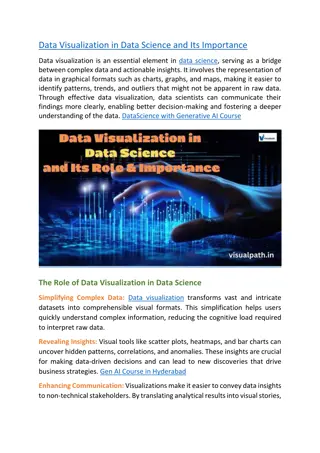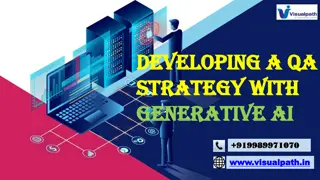Mastering Prompt Engineering for Effective Generative AI Communication
Explore the world of prompt engineering for generative AI learning and discover how to craft prompts to influence AI-generated content. Unveil the secrets behind AI behavior, the essence of prompt engineering, practical exercises, and the limitations of current AI capabilities. Enhance your skills in leveraging AI to enhance event planning, hiring processes, and more.
Download Presentation

Please find below an Image/Link to download the presentation.
The content on the website is provided AS IS for your information and personal use only. It may not be sold, licensed, or shared on other websites without obtaining consent from the author.If you encounter any issues during the download, it is possible that the publisher has removed the file from their server.
You are allowed to download the files provided on this website for personal or commercial use, subject to the condition that they are used lawfully. All files are the property of their respective owners.
The content on the website is provided AS IS for your information and personal use only. It may not be sold, licensed, or shared on other websites without obtaining consent from the author.
E N D
Presentation Transcript
Intro to Prompt Engineering for Generative AI Learning to Converse with Robots
Agenda Introduction Understanding Prompt Engineering Practice Exercise 1 Practice Exercise 2 Limitations of Generative AI Practice Exercise 3 Practice Exercise 4 What Else Are We Using AI For? Conclusion Q&A
Introduction Workshop goals and agenda: Get into the details of what prompts are and how they function. Understanding how to craft prompts safely. Practice crafting prompts.
Ai, What is it? Ai is defined as A system that shows behavior that could be interpreted as human intelligence. - Doug Rose Ai thrives in an environment where there are defined rules and patterns that it can work with. This is where AI will seem the most Intelligent . If you have used any of the following, you have used Ai: T-9 Texting, Google Translate, Hulu, Alexa, ChatGPT, etc.
What is Prompt Engineering? Prompt engineering is the process of designing and crafting input prompts or queries to generative AI models to elicit desired outputs or responses. The choice of words, format, and context in the prompt can significantly influence the generated content. Tips for structuring prompts for desired outputs: Be Clear and Specific Specify the Format Add Context Use Examples Control the Tone Ask the Model to Think Step by Step Use Keywords Provide Constraints Experiment Iterate and Refine
Practice 1 You have an upcoming event you are coordinating that will include a lecture from an expert in your department s field, followed by a panel with faculty and someone from the community. You would like to use Generative AI to help generate the title for your event as well as a blurb/description you can post on your website, Griz Hub, and email invitations.
Practice 2 You are on a search committee working to hire a new employee. You would like to use Generative AI to help generate questions for your interviews and reference checks. You are preparing for the new employee to start in your office next week. How can you use Generative AI to help put together a schedule for their first day/week?
Limitations of Ai Lack of Understanding: Generative models don't have true understanding of the text they generate. They generate responses based on statistical patterns, which means they can't answer questions that require deep understanding or common-sense reasoning. Biases: Generative AI can inadvertently perpetuate biases present in the training data. This can result in biased or discriminatory content. Efforts are ongoing to reduce bias, but it remains a challenge. Safety and Privacy: Be aware of what data is collected through your use of Ai. If a service is free, you are the product. ChatGPT for example collects all data you give it from its browser app in the free tier.
Limitations of Ai Overgeneration: Generative models can be verbose and tend to over generate content. They may produce longer responses than necessary, affecting readability. Inconsistency: The same prompt given to a generative model may produce different responses at different times. While it s useful for creativity, it can result in inconsistent/contradictory answers. Data Dependency: Quality of the generated text depends on the quality and diversity of the training data. Limited or biased training data can result in poor performance. ChatGPT3.5 for example only has data up to January 2022. Prompt Sensitivity: The way a prompt is framed can significantly impact the output. Crafting effective prompts requires practice and experimentation.
Practice 3 You are planning to update a policy/procedure in your department. How might you use Generative AI to help update the document?
Practice 4 You are using a survey to solicit feedback from people who attended a workshop. How can you utilize Generative AI to create the survey?
What Else Are We Using AI For? What are some other things you currently use (or have ideas about using) Generative AI for?
Conclusion Prompt Engineering is like any other skill, it takes practice. AI is not perfect, it will make mistakes. Attention to detail and specific prompting will help minimize these errors. Talk about it! Ask other people in your department and in your life what they are using it for. You may come across new ideas or ways of using AI that you have not thought of!
Q&A Does anyone have any questions about what we have covered today?
Thank You! I appreciate all of you taking the time to come learn with me today ! Please feel free to reach out to me with any other questions you may have! Tanner Dodd, Sr. Auditor, Internal Audit Dept. Tanner.Dodd@umt.edu (406) 243-2553























